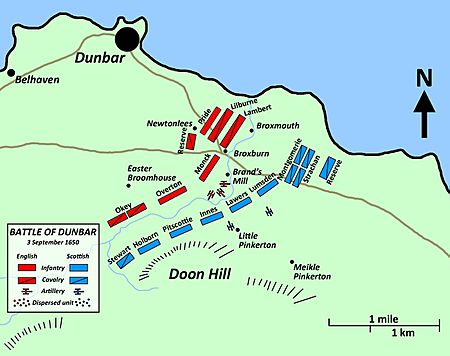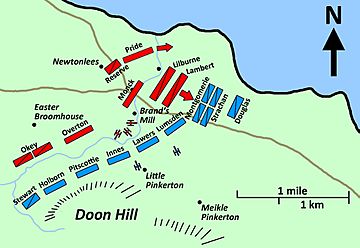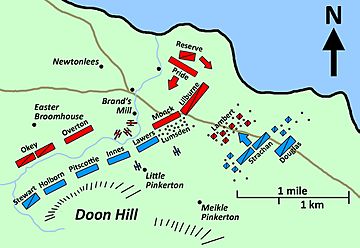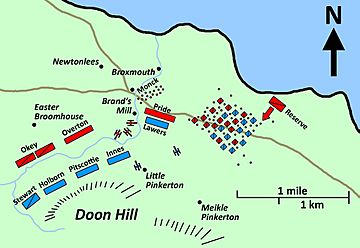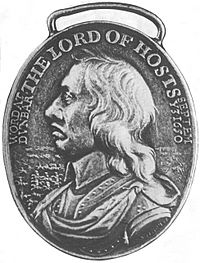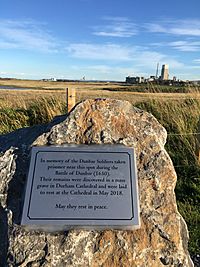Battle of Dunbar (1650) facts for kids
Quick facts for kids Battle of Dunbar (1650) |
|||||||
|---|---|---|---|---|---|---|---|
| Part of the Third English Civil War | |||||||
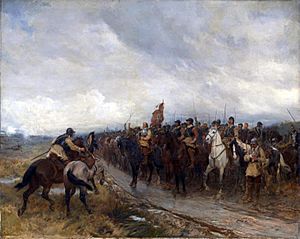 Cromwell at Dunbar, 1886, by Andrew Carrick Gow |
|||||||
|
|||||||
| Belligerents | |||||||
| Commanders and leaders | |||||||
| David Leslie | Oliver Cromwell | ||||||
| Strength | |||||||
| 8,000–9,500 infantry 2,000–3,000 cavalry 32 guns Total: 10,000–12,500 |
7,500 infantry 3,500 cavalry 22 guns Total: 11,000 |
||||||
| Casualties and losses | |||||||
| 300–500 killed 1,000 wounded 6,000 prisoners See "Casualties" for further details |
20–40 killed | ||||||
| Official name | Battle of Dunbar II | ||||||
| Designated | 21 March 2011 | ||||||
| Reference no. | BTL7 | ||||||
The Battle of Dunbar was a big fight between the English army, led by Oliver Cromwell, and a Scottish army, led by David Leslie. It happened on September 3, 1650, near Dunbar, Scotland. The English won a clear victory.
This battle was the first major fight in the Third English Civil War. This war started because Scotland accepted Charles II as their king after his father, Charles I, was executed in 1649.
After Charles I was executed, England became a republic called the Commonwealth. But Scotland still believed in having a king. They recognized Charles II as the king of all Britain and started building an army to support him. So, England sent its army, the New Model Army, led by Cromwell, into Scotland on July 22, 1650.
The Scottish army pulled back to Edinburgh, burning crops and supplies as they went. This was called a "scorched earth" tactic. Cromwell tried to make the Scots fight a big battle, but they stayed behind their strong defenses. By late August, Cromwell's army was weak from sickness and lack of food. He had to retreat to the port of Dunbar. The Scottish army followed and took a very strong position on Doon Hill, which overlooked Dunbar.
On September 2, the Scots moved closer to Dunbar, and the English set up their positions outside the town. Many of the Scottish army's best soldiers had been sent away in religious "purges," which weakened their army.
Before sunrise on September 3, the English launched a surprise attack. The Scots were not ready. The main fighting was on the north-eastern side, with both sides' cavalry and infantry fighting hard. Because of the hilly land, Leslie couldn't send more troops to help. Cromwell used his last reserve troops to attack the Scots from the side. The Scottish cavalry broke and ran away. The Scottish infantry fought as they retreated but lost many men. About 300 to 500 Scots were killed, 1,000 were hurt, and at least 6,000 were taken prisoner. The English lost only 20 to 40 men.
After the battle, the Scottish government went to Stirling. Leslie gathered what was left of his army there. The English took over Edinburgh and the important port of Leith. In the summer of 1651, the English crossed the Firth of Forth and landed in Fife. They defeated the Scots at Inverkeithing, which threatened the Scottish strongholds further north. Leslie and Charles II marched south, hoping to get support in England, but they didn't succeed. The Scottish government had no choice but to surrender to Cromwell. Cromwell then followed the Scottish army south. Exactly one year after the Battle of Dunbar, Cromwell crushed the Scottish army at the Battle of Worcester, ending the war.
Contents
Why the Battle Happened
The English Civil Wars
For many years, there were problems between King Charles I and the English Parliament. This led to a war in 1642, called the First English Civil War. Charles was also king of Scotland, but he had fought with the Scots before over their church. The Scots, called Covenanters, wanted their church to be different from the English church.
In England, the King's supporters (Royalists) fought against Parliament and the Scots. The Scots helped Parliament because they agreed to make the English church more like the Scottish one. After four years, the Royalists lost. King Charles I surrendered to the Scots in 1646.
The Scots and English Parliament tried to make a peace deal with the King. But Charles I didn't agree to their terms. So, the Scots handed him over to the English Parliament in 1647.
Charles II Becomes King
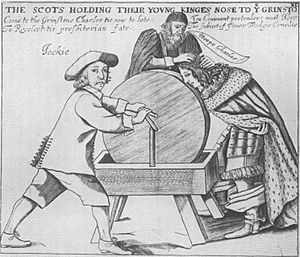
The English army, called the New Model Army, was tired of the fighting. They removed some members from Parliament and put King Charles I on trial. He was found guilty of treason and executed on January 30, 1649. England then became a republic, the Commonwealth.
But the Scottish Parliament did not agree with this. They declared Charles I's son, also named Charles, as the new King of Britain. Before he could return from exile, they made him agree to their rules. He had to promise to support the Scottish church and Parliament. Charles II finally agreed to these terms in May 1650.
Scotland quickly started building a new army for their new king. The English leaders felt threatened by this. They asked their army commander, Thomas Fairfax, to attack Scotland first. Fairfax didn't want to attack his former allies, so he resigned. Oliver Cromwell then became the new commander of the English army. He marched into Scotland on July 22, 1650.
Getting Ready for Battle

After Charles II agreed to be king, the Scottish Parliament started gathering men for a new army. David Leslie was their commander. They hoped to have 36,000 soldiers, but they never reached that number. When Cromwell entered Scotland, Leslie had about 8,000 to 9,500 foot soldiers and 2,000 to 3,000 horsemen.
The Scottish government also decided to remove any soldiers who were thought to be against their religious beliefs. This meant many experienced officers and about 4,000 men were sent away. This weakened the army and lowered morale.
Leslie set up strong defenses between Edinburgh and Leith. He also used a "scorched earth" tactic, burning crops and supplies between his lines and the English border. This made it hard for Cromwell's army to find food. Cromwell had to get supplies by sea and captured the ports of Dunbar and Musselburgh. Bad weather and lack of food made many English soldiers sick, reducing their numbers.
Cromwell tried to get the Scots to fight near Edinburgh, but Leslie wouldn't leave his strong defenses. Leslie believed that the bad weather and sickness would force Cromwell to retreat back to England.

On August 31, Cromwell did start to retreat. His army reached Dunbar on September 1, tired and hungry. The Scots followed them, blocking the road to England at a narrow pass called Cockburnspath Defile. The main Scottish army set up camp on Doon Hill, which was very hard to attack directly. The English army was trapped, but they could still get supplies by sea. Cromwell wrote that his army was "sick beyond imagination."
The Armies
Both armies had similar types of soldiers:
- Infantry (Foot Soldiers): These soldiers used long wooden spears called pikes and guns called muskets. Muskets were about 4 feet long and used a slow-burning cord to fire. Pikemen carried swords and wore steel helmets.
- Cavalry (Horse Soldiers): English cavalry rode large horses and wore metal helmets. They carried two pistols and a sword. Scottish cavalry had smaller, lighter horses and some used lances instead of pistols.
- Dragoons: These were soldiers who could ride horses quickly but would get off their horses to fight with guns. They were often used for scouting.
- Artillery (Cannons): Both sides had cannons, but they were hard to move once set up.
The Scottish army had about 8,000 to 9,500 foot soldiers and fewer than 3,000 horsemen. The English army started with about 16,000 men, but by the battle, sickness had reduced them to about 7,500 foot soldiers and 3,500 horsemen.
The Battle of Dunbar
Getting Ready to Fight
The Scottish army's position on Doon Hill was strong, but it was hard to get food and supplies to them. The weather was also very bad. On September 2, the Scottish leaders decided to move their army off the hill. This took most of the day.
The English army moved out of Dunbar and took positions along the Broxburn stream. Both armies put most of their horsemen on the side closest to the sea, where the stream was easier to cross. The Scots tried to move their foot soldiers to the east, but the rough ground made it hard, and they didn't finish before nightfall.
Cromwell planned a surprise attack for dawn on September 3. The English army moved into position all night in the dark and rain. Around 10 PM on September 2, English dragoons checked the Scottish positions. The Scots were on alert, but the English pulled back slightly. Many Scottish soldiers tried to find shelter from the wind and rain. Their officers were also scattered, and many of their musketeers were told to put out their slow-burning cords, which made their guns useless.
The Surprise Attack
Around 4:00 AM on September 3, English horsemen attacked the Scottish guards at the stream crossings. The guards were pushed back, and a confused fight began. The rain stopped, and moonlight briefly lit up the area. Both sides' cannons started firing.
Just after 5:00 AM, as dawn was breaking, English cavalry crossed the stream and formed up. The Scottish cavalry was not ready; some were still in their tents. The English surprised them and scattered them.
At the same time, English foot soldiers crossed the stream and attacked a Scottish infantry group. Many of these Scottish soldiers were new recruits and not well-prepared. The English musketeers fired twice and then charged with their pikemen. The English cannons also fired along the Scottish line. The Scottish group broke apart quickly.
Meanwhile, the English cavalry that had charged first got disorganized among the Scottish tents. Another group of Scottish cavalry counterattacked and pushed them back. More English cavalry crossed the stream to help. The fighting became a messy series of smaller battles across the field.
More English foot soldiers crossed the stream and moved to help the English troops who were being pushed back by the Scottish infantry. The battle was very close.
The English Win
Cromwell used his reserve troops to attack the Scottish cavalry from the side. This surprise attack caused the entire Scottish cavalry force to run away. Cromwell then sent his cavalry to where the foot soldiers were still fighting. They charged the Scottish infantry from the side, and the Scottish line collapsed.
According to English accounts, the remaining Scottish groups threw down their weapons and fled. However, some Scottish groups managed to retreat in good order. The Scottish cavalry that had been blocking the road to England also retreated and joined Leslie's main force as it pulled back towards Haddington, west of the battlefield.
What Happened After
Who Was Lost
The exact number of Scottish casualties is not fully known. Cromwell claimed about 4,000 Scots were killed and 10,000 captured. However, other sources say fewer, perhaps 300 to 500 Scots were killed, and about 1,000 were wounded. Around 6,000 Scots were taken prisoner. About 5,000 Scottish soldiers managed to escape. English casualties were very low, with only 20 to 40 killed.
Many of the Scottish prisoners were marched to England, and about 3,000 were held at Durham Cathedral. Many died on the march or in prison. In 2015, archaeologists found skeletons near Durham Cathedral that are believed to be these Scottish soldiers. Some survivors were sent to work as servants in other English lands.
England Takes Over Scotland
Later, English forces landed in Fife and captured Inverkeithing on July 20, 1651. This allowed the English to threaten Stirling and Perth. Leslie's army started to lose many soldiers who deserted. Cromwell, now healthy again, purposely left the path from Stirling to England open. Charles II and Leslie, with few other choices, marched south on July 31, hoping to get support in England. They had only about 12,000 men and few weapons. They tried to gather Royalist supporters in England, but not many joined them.
With Leslie and the army gone, Scotland was open to the English. The Scottish government in Perth surrendered to Cromwell two days after Charles and Leslie left Stirling. Cromwell and Lambert followed the Scottish army south, leaving Monck to finish taking over Scotland. By the end of August, Monck had captured Stirling and other towns. Dundee, the last major Scottish stronghold, fell on September 1.
Cromwell and his forces caught up with the Scottish army at Worcester. On September 3, 1651, exactly one year after Dunbar, Cromwell completely defeated them. Leslie and most of the Royalist leaders were captured. Charles II managed to escape. The Scottish government was ended, and the English took military control of Scotland.
The Dunbar Medal
After the battle, the English Parliament had a special medal made for the soldiers who fought. It was gold for officers and silver for regular soldiers. This is thought to be the first time a medal was given to all ranks of an army. It showed Cromwell's face and the army's battle cry, "The Lord Of Hosts." The other side showed Parliament.
The Battlefield Today
The battle is known as the Battle of Dunbar because it was fought near the town of Dunbar. Today, the area where the battle happened is recognized as an important historical battlefield by Historic Environment Scotland.
Some parts of the battlefield have been changed by quarrying (digging for stone) and by building a railway and a main road. However, a large part of the original landscape still exists, especially around Broxburn House. The exact spot of the English camp is probably now covered by the town of Dunbar. No items from the battle have been found yet, but experts think that musket balls and graves might be discovered in the future. There is one known grave at the site, that of Sir William Douglas, near Broxmouth House.
Images for kids
See also
 In Spanish: Batalla de Dunbar (1650) para niños
In Spanish: Batalla de Dunbar (1650) para niños


